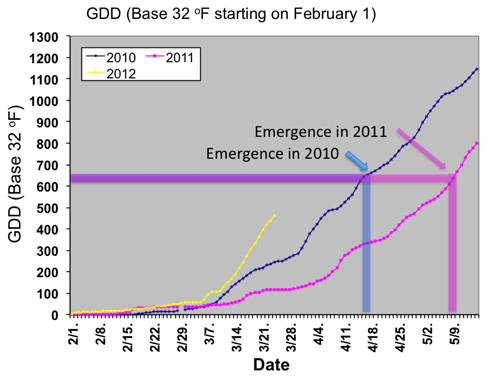Asparagus growers should prepare for the possibility of a very early harvest
The prevailing warm weather and short term forecast suggest that asparagus harvest may begin particularly early this year.
Information on asparagus emergence may help commercial growers prepare for harvest, especially in situations where labor might be a limiting factor. The importance of temperature on plant growth and development is well understood. In many situations, temperature has been used successfully as a predictor for plant growth processes. However, attempts to develop temperature-based predictive models for asparagus emergence have resulted in poor prediction accuracy. This failure to develop a robust predictive model is likely due to multiple factors. The temperature threshold needed to lift crown dormancy and initiate bud development may differ significantly from the temperature required for spear growth and emergence.
Most models have used short-term air or soil temperature data (one to three weeks), and therefore haven’t taken into account crown dormancy and bud development. While high temperature thresholds (about 50°F) may be needed for final spear emergence, it is likely that under cool climates like Michigan and Ontario, Canada, lower temperatures may be needed to break crown dormancy and initiate bud development.
In 2010, a study was initiated to determine the effect of temperature on asparagus spear emergence, and to attempt to develop a model that could be used to predict spear emergence. If successful, the information provided would be valuable to growers for planning purposes – both for digging crowns and for field harvest.
In 2010, asparagus emergence in most fields near Hart, Mich., was April 15-16. In 2011, emergence did not occur until May 8-9. Both air and soil temperatures were used as variables to predict asparagus emergence. To our surprise, air temperature was generally a better predictor than soil temperature. Comparisons of various base temperatures (32, 35, 40, and 50°F) for degree day calculations showed that 32°F provided consistent predictions for both 2010 and 2011. In both years, asparagus emerged when we had accumulated 600-650 GDD with the starting date of February 1 for each year.
Based on this information, which is very preliminary at this stage (due to the limited number of years), it is likely that we may have a very early harvest season for asparagus if current weather conditions prevail. As of March 17, 2012, the Enviro-weather station at the Asparagus Research Farm in Hart, Mich., has accumulated 277.8 GDD, compared to 181.9 GDD in 2010 and 90.7 GDD in 2011. As most people will recall, 2010 had a warm spring and asparagus harvest began on April 29 -30 compared to May 8-10 for the 2011 season.
It is very possible that harvest could begin in early April this year. For more information, visit the Enviro-weather website and the MSU Extension News article by Jeff Andresen and Aaron Pollyea, “Record-breaking warm weather advances beginning of growing season.”
Effect of growing degree days (GDD) on asparagus emergence. GDD calculation using the Baskerville-Emin Methodology.




 Print
Print Email
Email




